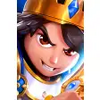Survival horror game with a science fiction bent released in 2015
Survival horror game with a science fiction bent released in 2015
Vote: (8 votes)
Program license: Paid
Developer: Frictional Games
Works under: Windows
Vote:
Program license
(8 votes)
Paid
Developer
Frictional Games
Works under:
Windows
Pros
- Deep, thought-provoking narrative
- High level of environmental interaction
- Effective balance of horror and storytelling
- Intriguing existential themes
- Impressive audiovisual polish
Cons
- Occasional technical issues like crashes
- Enemies become less frightening over time
- Some horror elements might feel less impactful
Dive into a Deep, Disturbing Ocean of Fear with SOMA
An Underwater Descent into Madness
SOMA by Frictional Games, the masterminds behind cult-classic horror titles like Penumbra and Amnesia, is a foray into the depths of both the ocean and the human consciousness. Set within the murky confines of an underwater research facility, SOMA unfolds a sci-fi narrative that intertwines terror with an exploration of existential themes, attempting to unite gripping storytelling with an unsettling atmosphere.
An Engaging Tangible World
Right from the outset, SOMA showcases its heritage, effectively employing environmental interaction mechanics reminiscent of Amnesia. Players assume the role of Simon, whose primary form of agency within this submerged world is to manipulate objects—everything from picking up tools to prying open sealed doors. Actions are performed with a pleasing tactility using mouse or controller inputs, creating an intimate connection between player, character, and the derelict surroundings.
The physicality of SOMA’s mechanics extends beyond mere manipulation of objects; it enriches the entire experience, grounding players in the protagonist's plight as the story's complexity unfurls.
Storytelling at Its Finest
Frictional Games has evidently shifted its focus to narrative within SOMA. Unlike their earlier protagonists, Simon has a more concrete background and persona that players can relate to. Similarly, the environment is more intricate and alive than the haunting yet less personal locales of previous titles, boasting a world filled with finely-crafted details that foster immersion.
The narrative begins as a typical day turns into a surreal nightmare with Simon's consciousness being whisked away to the undersea facility PATHOS-II after an ostensibly routine brain scan. The setting is as peculiar as it is oppressive, combining elements of organic life with cold, mechanical structures.
SOMA doesn't hesitate to experiment with its setting, leading players through locales that oscillate between claustrophobic interiors and the expansive, albeit equally threatening, oceanic abyss, managing to vary the rhythm of gameplay while amplifying the sense of dread.
Questioning Humanity and Reality
The journey SOMA takes players on isn't just through a haunted facility but also through philosophical territories, questioning the nature of existence and what it means to be human. The ever-shifting reality constantly tests Simon’s—and by extension, the player's—perception of self. As the game progresses, you are compelled to grapple with these profound questions, comprehending SOMA's truths through exploration and discovery.
Enemies and Fear Redefined
The entities encountered in SOMA provide a tangible element of fear. These adversaries, part machine and part organic, blur the lines between the living and the dead. With defense not an option, survival is about stealth and evasion. However, the delineation of foes' origins slightly diminishes the overall horror, making them less terrifying than the ambiguous entities of Amnesia. Eventually, as the narrative unfolds and personal theories about Simon's reality solidify, these creatures can transition from terrifying threats to mere hindrances on the path of discovery.
Companionship in Isolation
In a deviation from total isolation typical of horror games, SOMA allows for some semblance of interaction and companionship via technology. This narrative device serves the dual purpose of advancing the complex plot and providing temporary reprieve from the claustrophobic setting. Remote communication, encounters with AI, and the digital ghosts residing in the machinery offer moments of connection that, while reducing immediate tension, enhance the layered storytelling.
Visuals and Performance
SOMA presents a significant advancement in visual quality and polish over Frictional Games's earlier works, with its high fidelity creating a credible and hair-raising aquatic world. Nonetheless, players may occasionally encounter stability issues, such as crashes, that can temporarily take them out of the experience.
Conclusion
While SOMA's gameplay and horror elements echo its predecessors, the game distinguishes itself through its impressive narrative and philosophical depth. The setting may sometimes detach players from the horror aspect due to its explanatory nature, but when it hits, it remains chilling. The tension is balanced well enough for most players to see the story through to the end, providing a haunting journey through a carefully woven sci-fi saga.
Pros
- Deep, thought-provoking narrative
- High level of environmental interaction
- Effective balance of horror and storytelling
- Intriguing existential themes
- Impressive audiovisual polish
Cons
- Occasional technical issues like crashes
- Enemies become less frightening over time
- Some horror elements might feel less impactful




